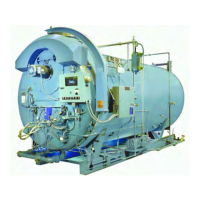Chapter 8 — Inspection and Maintenance
Part No. 750-184 8-25
Door bolts should be run in snug and tightened evenly to avoid cocking the
door and damaging the gasket. Start tightening at top center and alternate
between the top and bottom bolts until both are tight. Do not overtighten.
Tighten alternate bolts until the door is secured and gas tight. After the boiler
is back in operation, retighten the bolts to compensate for any expansion.
Loosen the nut on the davit stud to release tension from the davit arm.
U. REFRACTORY
The boiler is shipped with completely installed refractory. The refractory
consists of the cast dry oven, furnace liner, and the rear door. Normal
maintenance requires little time and expense, and prolongs the operating life
of the refractory.
Preventive maintenance through periodic inspection will keep the operator
informed of the condition of the refractory, and will guard against unexpected
and unwanted downtime and major repairs.
Frequent wash coating of the refractory surfaces is recom-mended. High-
temperature-bonding, air-dry type mortar, diluted with water to the
consistency of light cream, is used for wash coating. Recoating intervals will
vary with operating loads and are best determined by the operator when the
boiler is opened for inspection.
Furnace Liner
Maintenance consists of occasional wash coating of the entire liner. Face all
joints or cracks by applying high temperature bonding mortar with a trowel
or fingertips. Wash coating should be done as soon as cracks are detected.
Should segments of the liner burn away or fall out, replace the entire
refractory. Any refractory that may break out should be removed as soon as
detected so that it will not fuse to the bottom of the furnace and obstruct the
flame.
If replacement is necessary, refer to Chapter 9 and order proper replacement
materials. Remove existing refractory. Thoroughly clean the furnace to
remove all old refractory cement or other foreign material to ensure the new
liner seats firmly against the steel. Inspect the furnace metal.
Depending upon the design pressure of the boiler, the furnace may be of the
corrugated type. It is necessary to fill in the corrugation valleys under the
furnace liner tile from 4 o’clock to 8 o’clock with insulating cement. The liner
tile should be fitted tightly against the crown of the corrugation.
Note: The area between the dry oven and the throat tile
requires a good seal. An improper or poor seal allows air
leaks that can cause overheating and burning of the dry
oven. The area should be inspected semi-annually. Contact
your local Cleaver-Brooks representative for information
and service.

